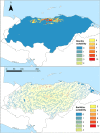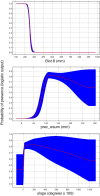Climate change models predict decreases in the range of a microendemic freshwater fish in Honduras
- PMID: 32728139
- PMCID: PMC7391645
- DOI: 10.1038/s41598-020-69579-7
Climate change models predict decreases in the range of a microendemic freshwater fish in Honduras
Abstract
Despite their incredible diversity, relatively little work has been done to assess impacts of climate change on tropical freshwater organisms. Chortiheros wesseli is a species of Neotropical cichlid (Cichlidae: Cichlinae) restricted to only a few river drainages in the Caribbean-slope of Honduras. Little is known about this species and few specimens had been collected until recently; however, our work with this species in the wild has led to a better understanding of its ecology and habitat preferences making it an excellent model for how freshwater fishes can be affected by climate change. This study assesses the distribution and habitats of Chortiheros wesseli using a combination of field data and species distribution modeling. Results indicate this species is largely limited to its current range, with no realistic suitable habitat nearby. Empirical habitat data show that this species is limited to narrow and shallow flowing waters with rapids and boulders. This habitat type is highly influenced by precipitation, which contributed the greatest influence on the models of present and future habitat suitability. Although several localities are within boundaries of national protected areas, species distribution models all predict a reduction in the range of this freshwater fish based on climate change scenarios. The likelihood of a reduced range for this species will be intensified by adverse changes to its preferred habitats.
Conflict of interest statement
The authors declare no competing interests.
Figures






References
-
- Myers BJE, et al. Global synthesis of the documented and projected effects of climate change on inland fishes. Rev. Fish Biol. Fish. 2017;27(2):339–361.
-
- Tewksbury JJ, Huey RB, Deutsch CA. Putting the heat on tropical animals. Science. 2008;320(5881):1296–1297. - PubMed
-
- Senior RA, Hill JA, Edwards DP. Global loss of climate connectivity in tropical forests. Nat. Clim. Change. 2019;9:623–626.
-
- Dagosta FCP, de Pinna MC. (2019) The fishes of the Amazon: distribution and biogeographical patterns, with a comprehensive list of species. Bull. Am. Mus. Nat. Hist. 2019;431:1–163.
-
- Peterson AT, Soberón J. Species distribution modeling and ecological niche modeling: getting the concepts right. Nat. Conserv. 2012;10(2):102–107.
Publication types
LinkOut - more resources
Full Text Sources

